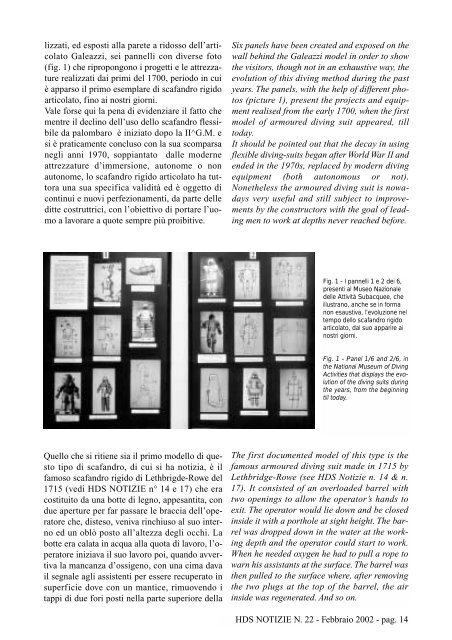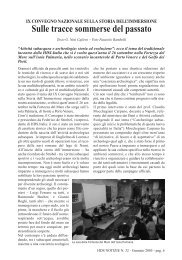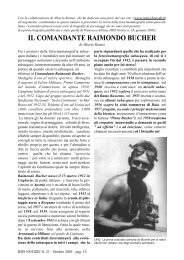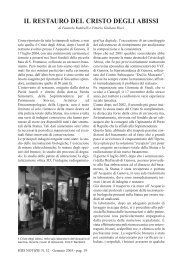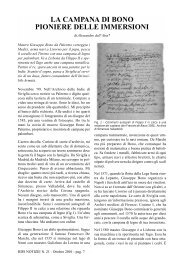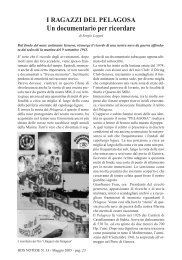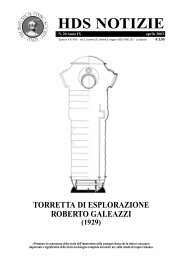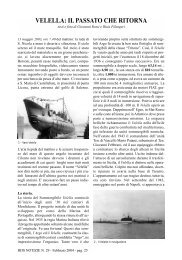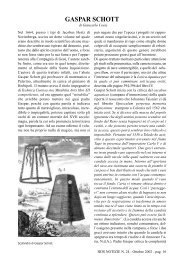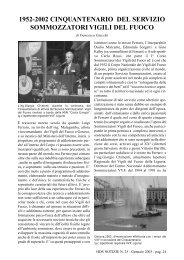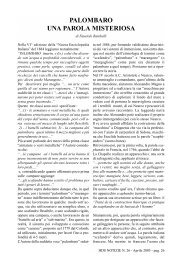hds internet - The Historical Diving Society Italia
hds internet - The Historical Diving Society Italia
hds internet - The Historical Diving Society Italia
You also want an ePaper? Increase the reach of your titles
YUMPU automatically turns print PDFs into web optimized ePapers that Google loves.
lizzati, ed esposti alla parete a ridosso dell’articolato<br />
Galeazzi, sei pannelli con diverse foto<br />
(fig. 1) che ripropongono i progetti e le attrezzature<br />
realizzati dai primi del 1700, periodo in cui<br />
è apparso il primo esemplare di scafandro rigido<br />
articolato, fino ai nostri giorni.<br />
Vale forse qui la pena di evidenziare il fatto che<br />
mentre il declino dell’uso dello scafandro flessibile<br />
da palombaro è iniziato dopo la II^G.M. e<br />
si è praticamente concluso con la sua scomparsa<br />
negli anni 1970, soppiantato dalle moderne<br />
attrezzature d’immersione, autonome o non<br />
autonome, lo scafandro rigido articolato ha tuttora<br />
una sua specifica validità ed è oggetto di<br />
continui e nuovi perfezionamenti, da parte delle<br />
ditte costruttrici, con l’obiettivo di portare l’uomo<br />
a lavorare a quote sempre più proibitive.<br />
Six panels have been created and exposed on the<br />
wall behind the Galeazzi model in order to show<br />
the visitors, though not in an exhaustive way, the<br />
evolution of this diving method during the past<br />
years. <strong>The</strong> panels, with the help of different photos<br />
(picture 1), present the projects and equipment<br />
realised from the early 1700, when the first<br />
model of armoured diving suit appeared, till<br />
today.<br />
It should be pointed out that the decay in using<br />
flexible diving-suits began after World War II and<br />
ended in the 1970s, replaced by modern diving<br />
equipment (both autonomous or not).<br />
Nonetheless the armoured diving suit is nowadays<br />
very useful and still subject to improvements<br />
by the constructors with the goal of leading<br />
men to work at depths never reached before.<br />
Fig. 1 - I pannelli 1 e 2 dei 6,<br />
presenti al Museo Nazionale<br />
delle Attività Subacquee, che<br />
illustrano, anche se in forma<br />
non esaustiva, l’evoluzione nel<br />
tempo dello scafandro rigido<br />
articolato, dal suo apparire ai<br />
nostri giorni.<br />
Fig. 1 - Panel 1/6 and 2/6, in<br />
the National Museum of <strong>Diving</strong><br />
Activities that displays the evolution<br />
of the diving suits during<br />
the years, from the beginning<br />
till today.<br />
Quello che si ritiene sia il primo modello di questo<br />
tipo di scafandro, di cui si ha notizia, è il<br />
famoso scafandro rigido di Lethbrigde-Rowe del<br />
1715 (vedi HDS NOTIZIE n° 14 e 17) che era<br />
costituito da una botte di legno, appesantita, con<br />
due aperture per far passare le braccia dell’operatore<br />
che, disteso, veniva rinchiuso al suo interno<br />
ed un oblò posto all’altezza degli occhi. La<br />
botte era calata in acqua alla quota di lavoro, l’operatore<br />
iniziava il suo lavoro poi, quando avvertiva<br />
la mancanza d’ossigeno, con una cima dava<br />
il segnale agli assistenti per essere recuperato in<br />
superficie dove con un mantice, rimuovendo i<br />
tappi di due fori posti nella parte superiore della<br />
<strong>The</strong> first documented model of this type is the<br />
famous armoured diving suit made in 1715 by<br />
Lethbridge-Rowe (see HDS Notizie n. 14 & n.<br />
17). It consisted of an overloaded barrel with<br />
two openings to allow the operator’s hands to<br />
exit. <strong>The</strong> operator would lie down and be closed<br />
inside it with a porthole at sight height. <strong>The</strong> barrel<br />
was dropped down in the water at the working<br />
depth and the operator could start to work.<br />
When he needed oxygen he had to pull a rope to<br />
warn his assistants at the surface. <strong>The</strong> barrel was<br />
then pulled to the surface where, after removing<br />
the two plugs at the top of the barrel, the air<br />
inside was regenerated. And so on.<br />
HDS NOTIZIE N. 22 - Febbraio 2002 - pag. 14


